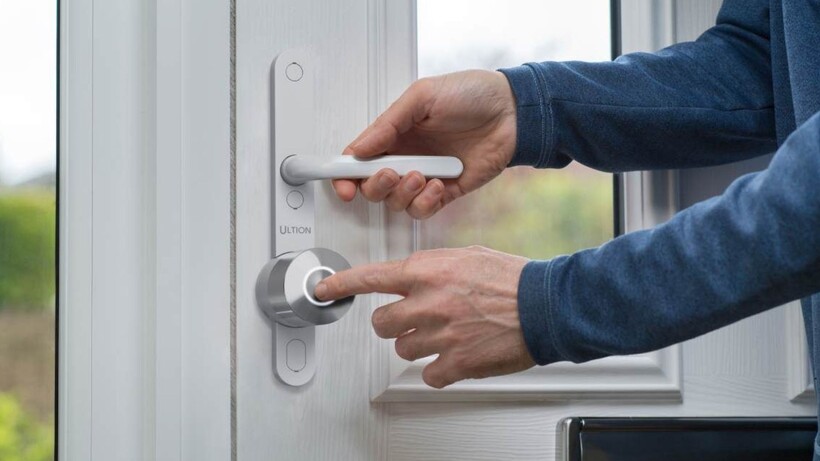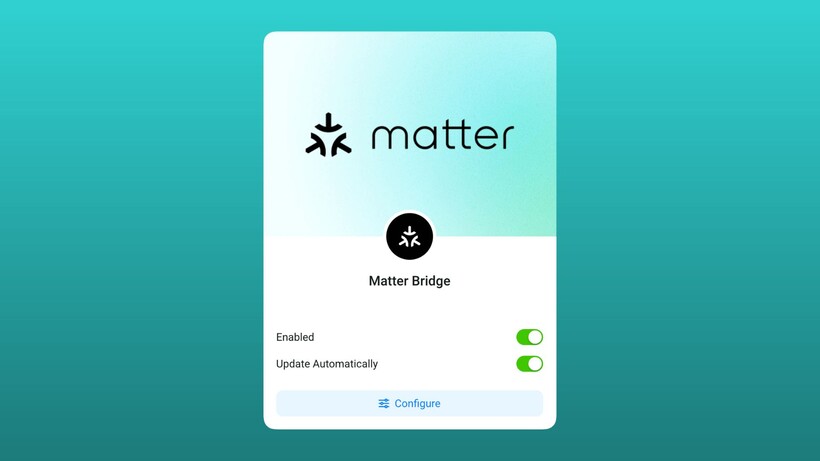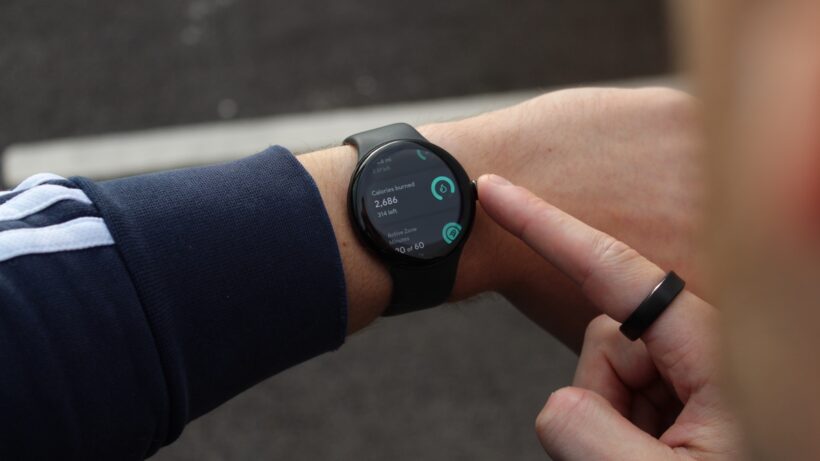
Smart rings represent the most exciting and fastest-moving area of wearables, with the top options offering accurate health tracking, sleep monitoring, and stress insights.
The market is booming in 2025. Yet it’s also an ever-expanding battleground—and we’re now seeing household names and startups chip away at Oura’s dominance.
Despite the increased competition, though, we still rate the Oura Ring 4 as the best smart ring you can buy. It offers a range of premium designs, the most polished app, and countless actionable insights into your nighttime rest, readiness, and body responses.
However, its mandatory subscription and premium price keep the door wide open for compelling, subscription-free alternatives. We’ve been very impressed by the Ultrahuman Ring Air, RingConn Gen 2, and Samsung Galaxy Ring during our in-depth testing.
Read on for our first-hand testing summaries of the best smart rings, along with advice on choosing between them.
Smart rings in 2025: The state of play and new launches
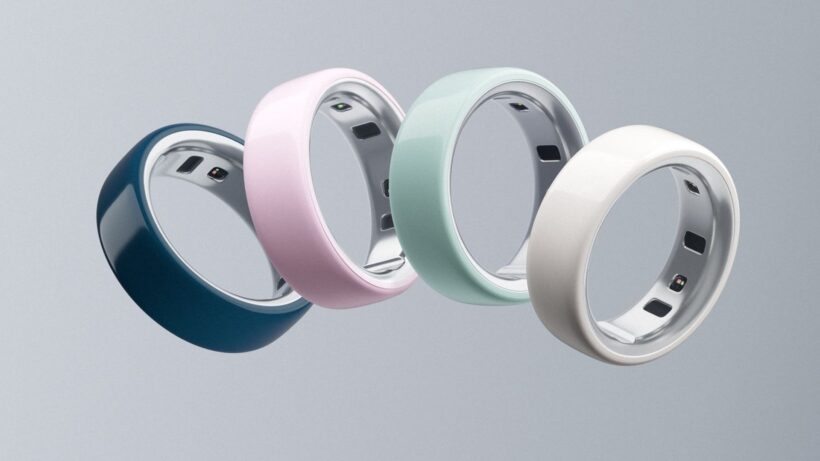
This has been a dramatic year of major launches and legal battles in the smart ring industry. Before we dive into the need-to-knows before choosing a smart ring, and our top recommendations, here’s a quick refresher on what happened and what we’re testing next.
How legal battles have defined the industry
This was the year the smart ring truly hit the mainstream, but it’s also been defined by conflict. Industry leader Oura announced it has now sold over 5.5 million rings, with revenue doubling as the category continues to explode.
Much of this growth happened amid high-profile patent disputes, as well. Oura successfully secured a US import ban on its chief rivals, Ultrahuman and RingConn, earlier in the year.
In October, RingConn agreed to pay royalties to Oura (just as Circular did before them) to resolve the ban, and that means it’s available to buy once again in the US.
The legal fight between Ultrahuman and Oura continues, however.
The notable smart ring hardware launches
Despite the courtroom battles, we’ve still seen a few notable new announcements: the Reebok Smart Ring, Luna Ring 2, and Sandbar Stream Ring. These are the focus of our upcoming testing.
Mid-cycle updates to existing tech from Oura (with its Ring 4 Ceramic collection, Ultrahuman (with its high-priced Rare smart ring), and RingConn (with the budget-friendly Gen 2 Air) have also arrived in 2025.
While Samsung opted not to release a follow-up this year (after its big 2024 launch), all eyes are on 2026 to see if a second-generation Samsung Galaxy Ring will materialize to challenge Oura’s dominance.
Smart rings: FAQs
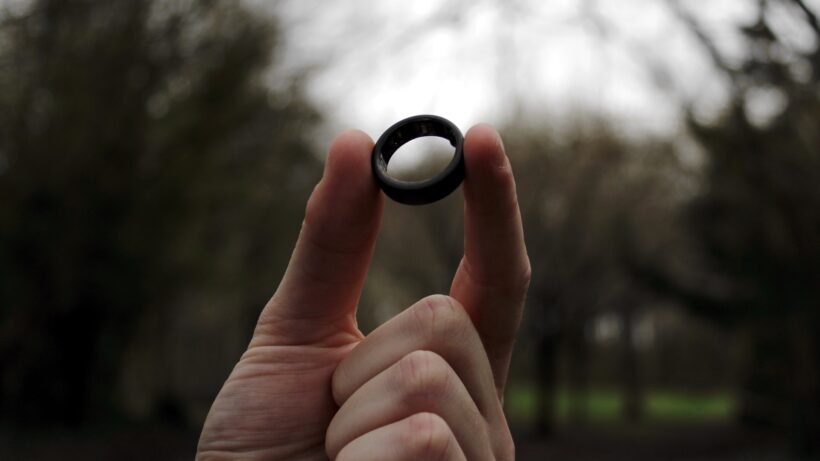
Smart rings are small, discreet wearables—ideal for those who want to enjoy the benefits of a wearable without the bulk of a smartwatch or fitness tracker.
They primarily track sleep, steps, recovery, and stress levels. Smart rings have gained popularity because they are more comfortable to sleep with than smartwatches. Additionally, they provide in-depth health insights while allowing you to wear your favorite watch or timepiece.
It depends, and this is a crucial factor. The industry leader, Oura, requires a $5.99/month subscription to access your full insights, historical data, and advanced features. Something like the new Reebok Smart Ring also requires a $99/year fee after the first year.
However, major alternatives like the Samsung Galaxy Ring, Ultrahuman Ring Air, and RingConn Gen 2 do not require any ongoing subscription fees to access your data.
Smart rings typically struggle with tracking workouts, and very few offer advanced health features like ECG or blood pressure monitoring. The absence of a screen and NFC also makes them feel less practical than a smartwatch on a daily basis.
Generally, smart rings are meant to be worn on the index finger, but you can wear them on any finger you prefer.
Most of the smart rings we’ve tested come with a sizing kit that includes a plastic version of the ring, allowing you to try a range of sizes before the smart version is shipped to you. Samsung’s sizing kit is optional, but do not skip this step.
It’s important to wear the test ring for a day or two to ensure it fits well and doesn’t slip off while washing your hands (we’re speaking from experience!). A snug fit that doesn’t twist is crucial for obtaining accurate sensor data, so this aspect is significant.
Smart rings take a battering, so getting something that won’t be torn to shreds after a couple of months is important. Many rings (see RingConn and Oura) are made of titanium, which is light and supposed to be very scratch resistant. Yet, we always suggest taking it off when doing activities like lifting weights, because it will get marked. Ring protectors can help with this.
Most smart rings are at least 5ATM water resistant, meaning they can be worn in the pool or shower. That’s not universal, though, and there are rings with lower ratings that only protect against washing your hands. Be aware.
Many of the rings we’ve encountered so far have been designed to monitor aspects of your health and fitness. Heart rate, SpO2 (blood oxygen), and temperature sensors are quite standard now. Additionally, we’re beginning to see the first rings capable of taking an ECG entering the market.
Neither is necessarily better; they serve different purposes. A smartwatch (like an Apple Watch) is an active companion for your wrist. It delivers notifications, apps, payments, and active workout tracking. A smart ring is (generally) a passive health monitor. It’s designed to be discreet, comfortable (especially for sleep), and provide deep insights into your body’s readiness, sleep quality, and stress, without the distracting screen.
At a glance: The top smart rings we’ve tested
- Our top recommendation: Oura Ring 4
- The best subscription-free smart ring: Ultrahuman Ring Air
- A top integrated choice for Samsung users: Samsung Galaxy Ring
- For excellent smart ring battery life: RingConn Gen 2
- The best medical smart ring: Prevention Circul+
How we test smart rings
Unlike most sites, Wareable has been testing smart rings since the early days, giving us extensive experience. We wear and compare smart rings constantly, and testing never stops.
Each has been worn for months—if not years—to assess how the data compares in terms of tracking accuracy and long-term insights.
The smart rings we recommend from our reviews
Oura Ring 4
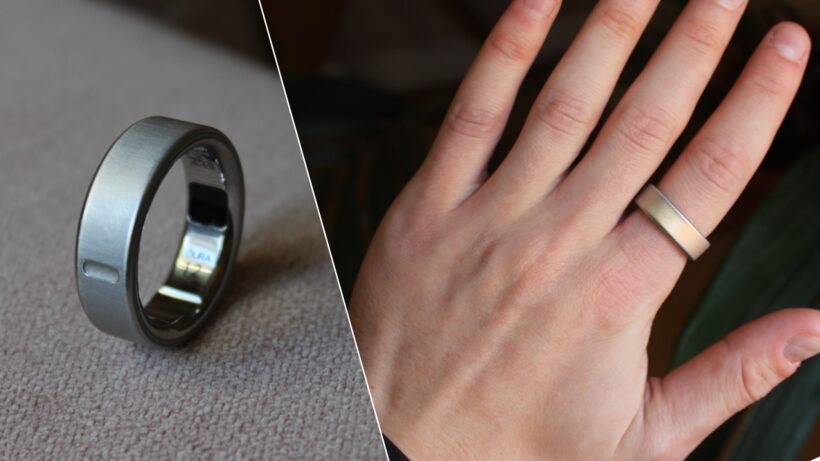
- Weight: 3-4 grams (depending on size)
- Sensors: PPG, skin temperature, accelerometer, IR sensor to check alignment
- Color options: Silver, brushed titanium, matte black, stealth black, rose gold, gold; ceramic finishes in tide, midnight, cloud, and pink
The Oura Ring 4 is the best smart ring money can buy—though it’s also the most expensive.
The app is the most polished we’ve used, and its sleep and health-tracking accuracy is also exceptional, supported by countless clinical trials. In addition to sleep tracking, it monitors readiness, stress, and activity, providing daily updates on core vitals, including breathing rate, heart rate, and body temperature.
In the last year or so, the platform updates have shifted the focus to tracking health over time, including stress resistance, cardio fitness and ‘age’, and how your sleep patterns align with your circadian rhythm. The latest, in October 2025, debuted improved cycle insights and a new stress-tracking metric, Cumulative Stress.
The app is also starting to track metabolic health, with the recent rollout of blood test integrations for those in the US. If you log meals using its AI identification algorithm, it will also analyze your meal regularity.
We love Oura—but it might not be right for you
Few wearables can match Oura’s simplicity, focus, and actionability. In our view, it easily justifies the subscription if you crave something beyond the typical, mind-melding historical graphs of countless metrics.
If you don’t, the expense of Oura—which starts at $349 and requires a $5.99 subscription—makes little sense. If you need an alternative, then consider the Ultrahuman Ring Air, RingConn Gen 2, or Galaxy Ring listed below.
Our only other key gripe with the Oura Ring 4 is its size. The brand didn’t slim down the profile for its latest generation—or the Ceramic collection that debuted in October.
So, while it’s lighter and more comfortable than Gen 3, it’s also bigger than its rivals. Again, if you want the thinnest smart ring, Oura Ring 4 isn’t it.
- Check out our Oura Ring 4 review
Ultrahuman Ring Air
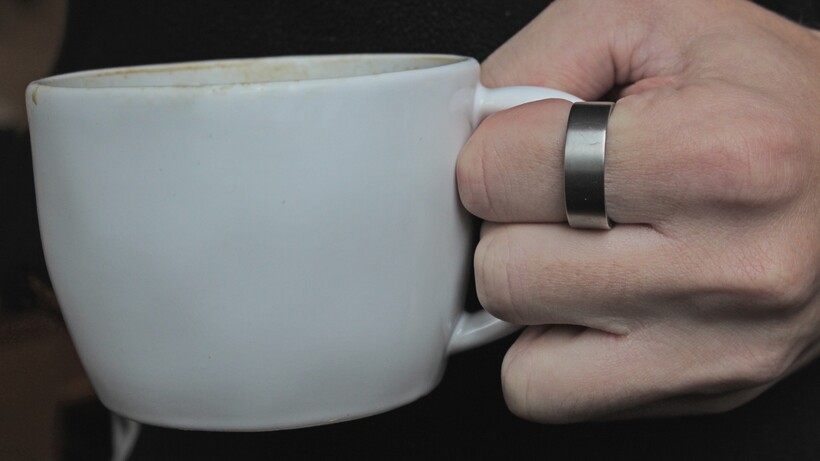
- Weight: 2.4g-3.6g (depending on size)
- Sensors: PPG, SpO2, skin temperature, accelerometer
- Color options: Aster Black, Matte Grey, Bionic Gold, and Space Silver
The Ultrahuman Ring Air is the company’s second-generation smart ring. At just 2.4 g, it’s lighter and smaller than its predecessor, making it more comfortable to wear—and it remains our favorite subscription-free smart ring. However, since its release in June 2023, rivals have begun to offer hardware and software that are equally compelling.
It primarily focuses on sleep, recovery, and stress tracking, with Ultrahuman placing a significant emphasis on analyzing circadian rhythms, managing stimulants, and promoting healthy wind-down times. The “Adenosine Clearance Window” is particularly interesting, as it guides you on when to drink coffee, and the circadian clock advises when to get light and take a walk.
Some of the metrics can feel a bit raw, and the app isn’t quite as well-designed as Oura, but it’s still a far nicer visual experience than accessing your data and insights from RingConn.
There’s also a recovery score that tracks metrics such as resting heart rate, HRV, and body temperature. These are compared to established baseline scores, and there’s a traffic light system to show if these are outside of your norms. Additionally, there are women’s health-tracking features that utilize biometric sensors to monitor the menstrual cycle.
The rest of the Ultrahuman experience & availability concerns
The Ultrahuman app also features a glucose component, which integrates with a continuous glucose monitor (CGM) when you purchase its M1 sensor package.
Ultrahuman also supports ‘PowerPlugs’ (a range of apps and integrations), a jet lag advisor, an AFib detection feature, and partnerships for blood marker detection. So, it’s an experience that’s quickly expanding.
The Ring Air costs $349 / £329 / €325 without an ongoing subscription, making it a good alternative to Oura on price.
Crucially, though, at the time of writing, the Ring Air is currently subject to a US import ban due to an ongoing patent dispute with Oura, which Ultrahuman is actively fighting.
In response, the company is focusing on global expansion for its advanced health platforms, recently launching its ‘Blood Vision’ analysis tool (which can integrate with blood tests) in the UK, Australia, and other new markets.
- Check out our full review of the Ultrahuman Ring Air
RingConn Gen 2
Price: $299 | RingConn
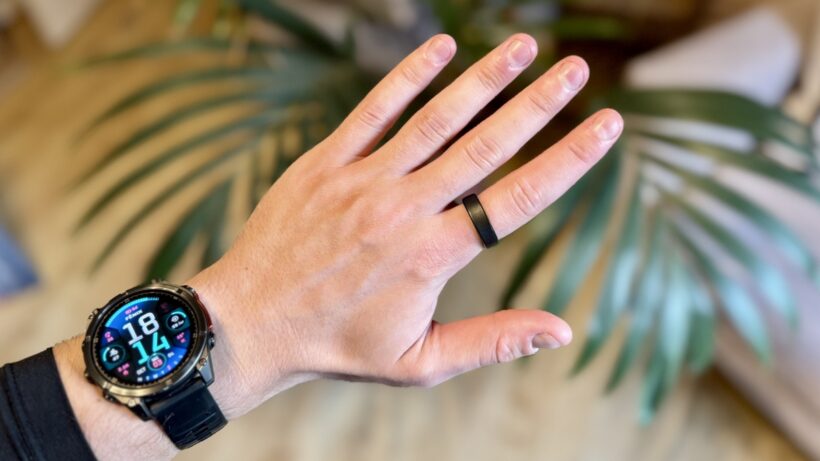
- Weight: 2-3g (depending on size)
- Sensors: PPG, SpO2, skin temperature, accelerometer
- Color options: Future Silver, Matte Black, Royal Gold
Despite only shipping its Gen 1 smart ring to crowdfunding backers in early 2024, RingConn quickly followed up with a second-gen option later that summer. The Gen 2’s incredibly light and thin design makes it arguably the best smart ring to own from a comfort perspective.
It’s also the undisputed battery champion. In the right settings, it can last 10-12 days on a single charge (up from the debut model’s seven-day battery life).
The design alone makes it a serious alternative to Oura and Samsung. RingConn has dropped the weight to around 2-3g (depending on your ring size), and the 2mm thickness makes it the slimmest on the market. This adds up to a feel in daily use and sleep tracking that’s as close to a regular ring as we’ve ever experienced.
Our only design concern during testing has been durability. Like most matte black rings, the edges have picked up slight signs of wear. RingConn is far from the only manufacturer to suffer from this, but it is worth keeping in mind when choosing your finish.
Like the first iteration, the Gen 2 ring produces accurate sleep, health, and basic activity insights. We found that only the sleep apnea feature has a significant impact on battery life.
How the experience stacks up
While this data is mostly acceptable, we still have reservations about the companion app.
It doesn’t exhibit the same level of polish or unique insights as a platform like Oura, and the endless graphs make it feel more like a data hub rather than a cohesive companion that fosters behavior change or provides valuable insights.
For many people, that will be just fine. But the best wearables make data actionable, and you’ll have to do much of that yourself with RingConn.
Still, with a price tag that undercuts rivals, no added subscription fees, and a nifty charging case that effectively gives you 15-20 charging cycles, the RingConn Gen 2 is a tough smart ring to argue against.
Again, for those who missed the mention up top, it’s worth repeating: RingConn recently settled a patent dispute with Oura and is now paying royalties to continue selling its ring in the US, resolving a previous import ban. That means this ring—and the cheaper Gen 2 Air—are readily available.
- Check out our full RingConn Gen 2 review
Samsung Galaxy Ring
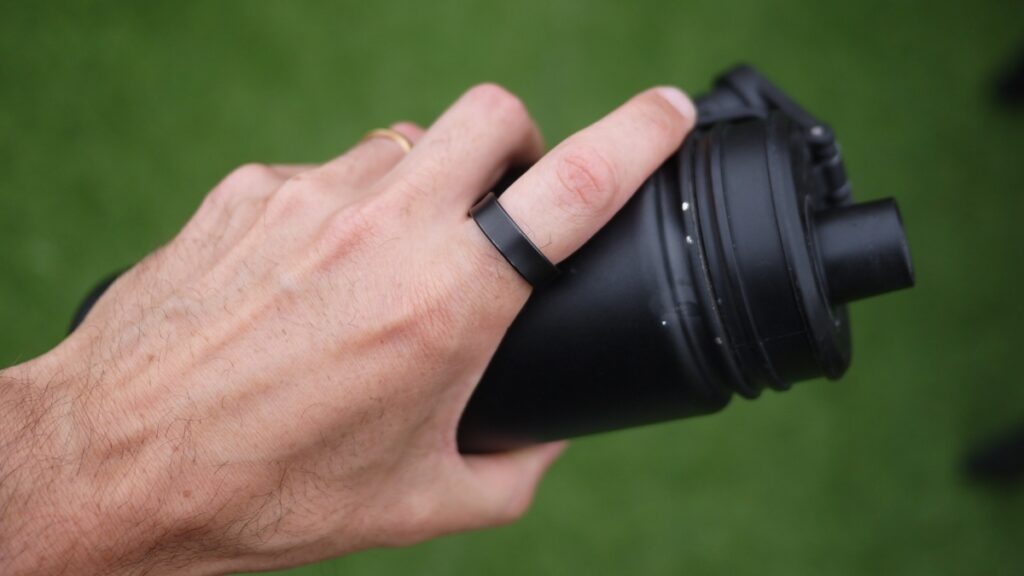
- Color options: Silver/Black/Gold
- Weight: 2.3-3 grams
- Sensors: Skin temp, PPG, accelerometer
The Samsung Galaxy Ring is a fantastic first-generation effort from Samsung. While not as insightful as Oura Ring 4, the Galaxy Ring gets sleep accuracy and activity tracking bang on.
The ring is Android-only, features a handy charging case, and comes at a pretty lofty price of $399. That’s more than the standard version of Oura’s Gen 4 ring, but, remember, Samsung’s offering doesn’t require a subscription.
Sleep is a huge focus of the Galaxy Ring, and this is backed up with nifty sleep coaching. Its chronotype feature characterizes your sleep patterns with an animal that exemplifies your habits. You can then work on improving specific areas of your sleep habits, making it feel actionable.
Samsung’s Energy Score is central to the experience; we found its daily figures, based on your sleep, HRV, and heart rate, to be responsive and intelligent. Additionally, the Galaxy AI provides insights into high or low scores.
Exercise heart rate was also better than any smart ring we’ve tested. However, we recommend ignoring the automatic workout detection and starting workouts manually via the app (and taking your smartphone).
Where does it rank?
So, why isn’t this the best smart ring to buy in 2025? You don’t get as many insights as Oura and Ultrahuman, even if Samsung covers the core experience just as well.
Recommending the Galaxy Ring to existing Galaxy smartwatch users is also problematic, as it offers no distinct advantages over the company’s existing smartwatches. In fact, it does much less, as it does not provide ECG, BIA, or blood pressure insights.
We also had some concerns over inaccurate SpO2 scores from our testing. Still, for a Gen 1 product, Samsung has got a lot right here. A 2025 follow-up has thus far failed to materialize, so we’re now likely looking at a 2026 announcement for the brand’s next smart ring.
- Check out our full Samsung Galaxy Ring review
Amazfit Helio

- Weight: 3.75-4g
- Color options: Titanium
- Sensors: PPG, accelerometer, temperature sensor, EDA sensor
We love the build and design of Helio; it’s one of our favorite smart rings to date, purely in terms of appearance and feel. The titanium alloy remained scratch-free throughout our weeks of testing, and it’s also slim and lightweight. Additionally, it is 10ATM water resistant.
The company has significantly reduced the price of the Helio Ring and completely revamped the app design, making it a more budget-friendly option for those looking to explore smart rings.
As of now, it is only available in US8, US10, and US12 sizes, but the main issue is that Helio does not offer much additional functionality. It provides data, such as readiness and recovery, to the Zepp Health app, along with sleep tracking metrics that are already included in the company’s smartwatches. Additionally, it will monitor sleep heart rate variability (HRV) and resting HR.
Our testing showed that the sleep data was significantly higher than that of the Whoop, Oura, and Apple Watch. Additionally, the insights provided are not as extensive as those of the similarly priced Ultrahuman, making it seem like a poor investment.
If you’re committed to Amazfit sports watches, this ring has the potential to serve as a great companion. Otherwise, proceed with caution.
- Read our full Amazfit Helio review
Circular Ring Slim

- Weight: 2 grams
- Sensors: PPG sensor, bioimpedance sensor, accelerometer
- Color options: Black
Update, November 2025: Circular has released a Ring 2. We’ll keep the entry below intact until our full Ring 2 review is published, though we recommend holding off on the Slim.
Smart ring startup Circular offers one of the industry’s thinnest and lightest rings, the $275 / £225 Circular Ring Slim. Although we were critical in our initial review, the company released an updated version in June 2024 that addressed many of our concerns about its scratch-resistant coating and water resistance.
It tips the scales at just 2g and measures 2.2mm thick. To put these specs into context, industry leader Oura’s Generation 3 Horizon model measures in at 2.55mm thick and clocks the scales at around 4-6g, while the Circular Ring Pro is 2.75mm and 4g.
The Circular Ring Slim features a three-axis accelerometer, temperature sensor, PPG sensor, and LEDs for monitoring various metrics, including breathing rate, heart rate variability, blood oxygen saturation, and heart rate.
The insights provided by the Kira+ app do lag behind the likes of Ultrahuman and Oura, but the company has now released new algorithms for workout tracking. We’re putting those to the test to see how they stack up. But for now, it’s hard to recommend the Circular Ring Slim over rivals.
- Read our full Circular Ring Slim review
Movano Evie Ring

- Weight: 3.2-3.7g
- Sensors: PPG sensor, temperature sensor, accelerometer, gyroscope
- Color options: Silver, rose gold, black (coming soon)
- Price: $269 | Movano
The Movano Evie Ring is a female-focused smart ring – so it’s one of the rare wearables designed with women’s health in mind.
We published an early review that concluded buyers should avoid the smart ring until the technical issues and basic nature of the tracking and analysis improve. On 16 September 2024, it was relaunched with many of our criticisms seemingly addressed. We’ll retest this year to see if the problems have been overcome.
On paper, Evie packs a bold design and thin build, which should make it more wearable. And the Evie Ring is available in three colors: gold, silver, and rose gold.
It doesn’t hold back on features, either. The Movano Evie will measure heart rate, HRV, sleep, respiratory rate, temperature, and blood oxygen levels. It will also track mood and menstrual cycle symptoms (via user input) and aims to provide a holistic overview of health and activity through the Daily Summary window.
Movano has sought FDA approval for its heart rate technology, which has not yet been awarded, demonstrating its commitment to accuracy.
- Read our early Movano Evie review
Prevention Circul+
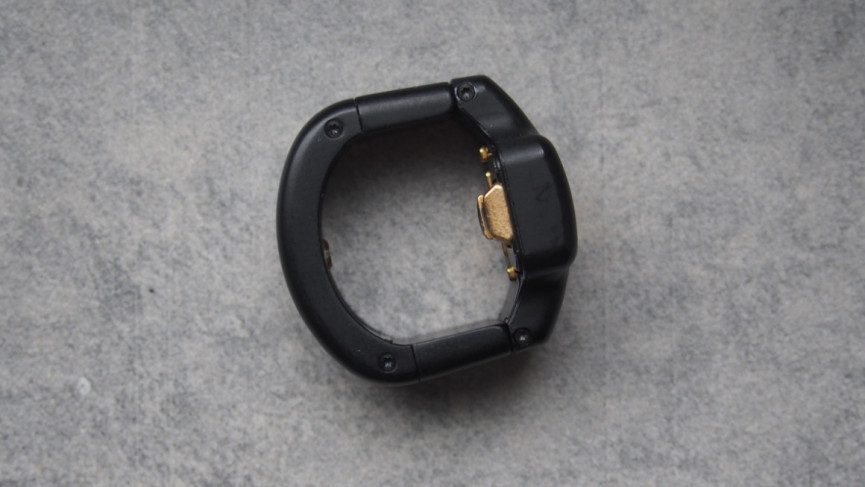
- Weight: 4.9 grams
- Sensors: Blood Pressure, ECG, Oximetry, Heart Rate, Temperature
- Color options: Silver, black, rose gold
- Price: $299 | Bodimetrics
We’ve seen ECG sensors on smartwatches and fitness trackers for years. However, Bodimetrics (in partnership with Prevention) has put that tech into a smart ring. It’s received FDA approval for its blood oxygen tracking—and, crucially, across all skin tones.
This clever ring tracks more than ECG. Once calibrated with a cuff monitor, it measures blood pressure too. It promises heart rate accuracy of ±2 bpm compared to medical-grade monitoring and ±3% accuracy for SpO2 monitoring as well.
Comparing the data from a blood pressure monitor, pulse oximeter, and other ECG wearables revealed good accuracy. However, its bulky design makes it suitable only for medical-grade tracking and condition management, not for daily activity monitoring.
The data is effectively presented but lacks actionable insights, as it mainly emphasizes vitals. If you need to monitor ECG and heart rate due to a medical condition, it serves that purpose. However, unlike consumer devices, it doesn’t indicate if you’re stressed, overtraining, or nearing your period.
What we liked
There’s more to sleep monitoring, allowing you to capture sleep duration, sleep stages (including REM time), heart rate, baseline skin temperature, and SpO2 levels, including an oxygen desaturation index.
The data seemed very reliable overall. Additionally, it can be stored freely in the app and cloud, and shared with doctors and healthcare professionals. However, with only 16 hours of battery life, you need to choose when to monitor statistics.
- Read our Prevention Circul+ review
Smart ring specs compared
| Smart Ring | Weight (grams) | Sensors | Color Options | Water Resistance |
|---|---|---|---|---|
Oura Ring Gen 4 | 4g | 18 signal pathway PPG, infrared LED, ambient light, accelerometer, | Silver, brushed silver, matte black, stealth black, rose gold, gold; | IPX8 (swim-proof up to 100 meters) |
| Samsung Galaxy Ring | 2.3g | Skin temp, PPG, accelerometer | Black, gold, silver | IP68/10ATM (100m) |
| RingConn Gen 2 | 2-3g | PPG, accelerometer, gyroscope | Silver, black, gold | IP68 (water resistant up to 50 meters) |
| Ultrahuman Ring Air | 3.6g | PPG, infrared LED, accelerometer | Stealth black, silver, rose gold | IPX8 (swim-proof up to 100 meters) |
| Circular Ring Slim | 2g | PPG, accelerometer | Black, silver, rose gold | IPX8 (as of June 2024) |
| Prevention Circul+ | 4.9g | PPG, accelerometer | Silver, black, rose gold | IP67 (water resistant up to 1 meter for 30 minutes) |
| Movano Evie Ring | 4.5g | PPG, accelerometer, gyroscope | Silver, rose gold, black (coming soon) | IPX8 (swim-proof up to 50 meters) |
| Amazfit Helio | 3.75g | PPG, accelerometer, temperature sensor, EDA sensor | ‘Titanium’ | IP68/10ATM (100m) |

